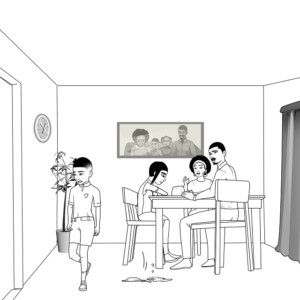
Teaching reading and comprehension can be difficult if English is not the first language, if a country has many other languages and if children have underlying attention difficulties such as ADHD. To help develop comprehension skills and improve English Grammar using this book, teachers can use the tips below::
I am not naughty- I really really mean it! is a children’s picture book which shares the story of the daily struggles of a young boy (Ayo) living with ADHD. The book helps English language learners achieve their Knowledge of English Language and Literacy goals by improving comprehension, improving grammar, and improving critical thinking. Through character representation used in the book, children are able to develop a better understanding of the context of their reading. When children can see themselves in stories, it becomes more meaningful. The book also promotes empathy, disability awareness and inclusion.
Use the book as a conversation starter and a reference to improve comprehension, vocabulary and disability awareness.
1. Read ‘I AM NOT NAUGHTY- I REALLY REALLY MEAN IT’ book to children.
2. Pick some scenes from the book, ask children to read aloud and play the characters in those scenes.
3. When they are done, discuss how the children feel about the main character and their scenes to reinforce understanding.
4. Use the open-ended questions contained in the book to reinforce comprehension.
5. Practice the pronunciation and meaning of new English words provided on the vocabulary page.
1. Free colouring activity sheets of ‘I am not naughty – I really really mean it!’ book can be downloaded below.


2. Book a free online reading session using the red button below and have the author read I am not naughty I really really mean it! book to your class.
3. Use the classroom tips below to support your learners with ADHD.
According to Dehaene (2020), attention is the gateway to learning. This is why the condition I have written about – Attention Deficit Hyperactivity Disorder (ADHD) is so important to learning. If we can’t get a child’s attention, we can’t teach the child English language or any other subject. Here are 5 tips for teachers to support children with ADHD especially during this distance or virtual learning period.
1. You may not be able to understand all the disability and neurodiversity conditions but you should equip yourself with the tell-tale signs so that you can identify them early and ask for specialist help. You can learn more about ADHD here.
2. Be flexible with your teaching. Allow them to move around. You can help them make up for what they have missed as a result of constantly moving by sending them activities to learn at their own pace. Also, incorporate physical activities into their learning e.g scavenger hunt where they hunt around their homes for items starting with a letter sound or jump spelling where they jump for every letter of a word they spell. Remember, if a child isn’t learning then we haven’t found the right way to teach the child yet.
3. Give intense praise and give it immediately because affected kids struggle to wait to receive gratification.
4. Use discussion style/video style/ debate style teaching methods e.g watch a video clip and talk about what you learnt in that video or record yourself discussing the video with someone in your household.
5. Most importantly carry the other children in your classroom along so that they understand and feel more positive about supporting. Empathy is crucial in supporting children with ADHD and other neurodiversity conditions.
BOOK A READING SESSION